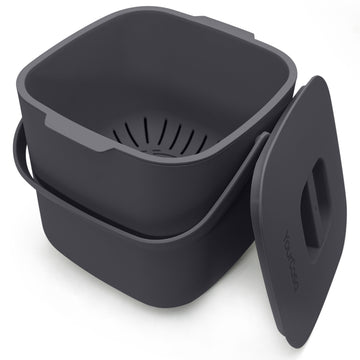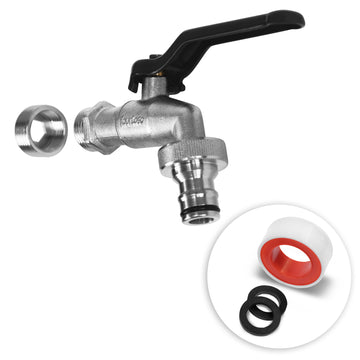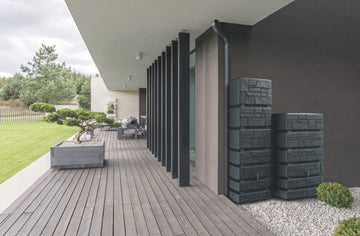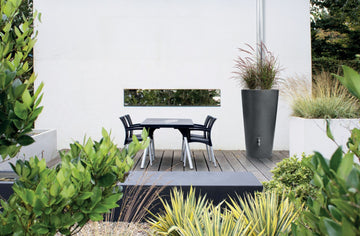5 common mistakes when collecting rainwater and how to avoid them
by Robert Zielinski on Jul 08, 2024
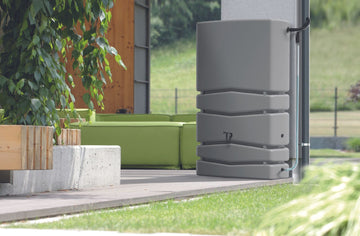
By collecting rainwater in your garden, you not only help protect the environment by using less valuable drinking water, but you also save money and do something good for your plants. However, beginners in particular often make mistakes that can affect the quality of the collected water.
You can find out what these mistakes are and how best to avoid them from the start in our guide. Discover practical solutions to use your rainwater cleanly and effectively while protecting the environment.
What mistakes can you make when collecting rainwater? The following mistakes can occur when collecting rainwater: The rain barrel is placed in the wrong location, which means less water is collected. No filter is used, which leads to contamination. The barrel is not cleaned regularly, which encourages dirt and algae growth. Inappropriate materials are used that break down more quickly or contaminate the water. In addition, people often forget to protect the barrel from direct sunlight, which encourages algae growth.
Mistake #1: Why is choosing the wrong material for your rain barrel problematic?
Mistakes in the choice of materials can lead to a shorter lifespan of the rain barrel or to poorer water quality . Many choose materials that are not suitable for the climatic conditions of their place of residence or for the intended use. Others do not take into account the maintenance requirements or are blinded by a low price without considering the long-term costs and benefits.
The following table provides an overview of the most common materials for rain barrels and their respective advantages and disadvantages.
| material | Advantages | Disadvantages | Care tips | Cost |
| plastic | Lightweight, cost-effective, easy installation | Susceptible to UV damage, can crack in extreme temperatures | Protect from direct sunlight, check regularly for cracks | Cheap to medium priced |
| Metal (stainless steel, galvanized steel) | Robust, durable, good UV protection, less susceptible to algae growth | Can rust if not treated properly, heavier and more expensive than plastic | Check regularly for rust spots and treat, protect from direct sunlight | Medium to high priced |
| Wood | Aesthetically pleasing, good insulation | Requires regular care, can rot, difficult | Oil or varnish regularly, protect from direct ground contact, keep dry | Medium to high priced |
| concrete | Very durable, good insulation, heavy | Very heavy, expensive, difficult to move | Regular inspection for cracks and efflorescence, possibly renew sealing | Highly priced |
| Clay/ceramics | Aesthetically pleasing, good insulation | Fragile, heavy, can be damaged by frost | Protect from frost, check regularly for cracks | Medium to high priced |
For most households, a plastic bin is suitable due to its cost-effectiveness and ease of use. However, if you value durability and robustness, you should opt for a metal or concrete bin. Wooden bins and clay/ceramic bins are particularly suitable for gardens where aesthetics and natural materials are the priority. However, these variants also require more maintenance.

Mistake #2: Why is a missing lid a big problem for your rain barrel?
If you don't always cover your rain barrel with a lid, it can quickly lead to problems. Pests and algae growth can then lead to poor water quality or even have health and environmental effects. Without a lid, leaves, dust and other debris can easily get into the barrel and contaminate the water.
Protection from insects , especially mosquitoes, is particularly important. Standing water in an open rain barrel is an ideal breeding ground for these pests. This can not only be annoying, but also pose health risks, as mosquitoes can transmit various diseases. Really serious diseases transmitted by mosquitoes are still rare in Germany and Central Europe, but are on the rise. Cases of West Nile fever, for example, have already been reported in Germany.
A lid prevents mosquitoes from getting into the bin and laying their eggs there. If you don't do this, mosquitoes can spread in your garden and transmit the following diseases, among others:
| Illness | Transmitting mosquito species | Symptoms | Mortality rate (%) | Cases per year in Germany | Further important information |
| West Nile fever | Culex | Fever, headache, joint pain, rash | <1% | Rarely | Can lead to serious neurological disorders |
| Dengue fever | Aedes | High fever, severe headache, pain behind the eyes, joint and muscle pain, skin rash | 1–2.5% | Rare, mainly imported cases | Severe cases especially in children and the elderly |
| Chikungunya fever | Aedes | Fever, severe joint pain, headache, muscle pain, rash | <1% | Rare, mainly imported cases | Pain can last for months |
A lid also protects the water from the formation of algae, which is promoted by direct sunlight. Algae can make the water unusable and cause unpleasant odors - some are even harmful to health:
| Algae species | Toxins | Negative effects |
| Blue-green algae (cyanobacteria) | Microcytins, anatoxins, saxitoxins | Toxic effects on humans and animals, skin irritation, nausea, liver and nerve damage |
| Green algae | No known toxins | Can clog filters and pumps, aesthetic and odor problems |
| Diatoms | No known toxins | Can clog filters and pumps, aesthetic and odor problems |
| Thread algae | No known toxins | Can cause blockages in pipes, aesthetic problems |
The lid therefore serves as essential protection against various external influences . Make sure that your rain barrel is delivered with a lid - otherwise you should add one straight away. Check regularly that the lid is firmly in place and undamaged. Some models also have special safety locks that prevent the lid from slipping due to wind or being removed by animals.
Mistake #3: What happens if your rainwater collection system doesn’t have an overflow?
Overflowing water can quickly cause damage in the garden . You might think that large rain barrels in particular take a long time to fill up - but in heavy rain, which is becoming more and more common in Germany, this can happen quite quickly. Excess water then runs uncontrollably over the edges and may cause water damage to the house and garden.
The water can undermine the foundations of your house , for example, which leads to structural damage in the long term. Puddles and standing water can also form in the garden, which not only looks unsightly, but can also damage plants and attract mosquitoes - and you now know what the latter can do. Paths and terraces are also not safe from overflowing water - and repairs can quickly become expensive.
To install an overflow , you only need a few tools and materials. Just follow these steps:
- Prepare tools and materials: Get the necessary tools and materials such as a drill, overflow nozzle, hose and fastening materials.
- Marking: Mark the spot where the overflow should be installed. This should be just below the top edge of the rain barrel.
- Drill hole: Drill a hole at the marked location.
- Insert overflow nozzle: Insert the appropriate overflow nozzle into the drilled hole and fasten it securely.
- Connect hose: Connect the overflow nozzle to a hose that will drain the excess water.
- Determine drainage location: Direct the hose to a suitable drainage location, such as a flower bed or a soakaway system.
- Attach the hose: Make sure the hose is well secured and free of kinks to ensure smooth water flow.
You see: in just a few steps you can protect your house and garden from flooding during heavy rain with the help of a rain barrel with overflow.
Mistake #4: Why is too small an overflow a common mistake?
You have installed an overflow? That's all well and good. But is it big enough? You should definitely check this. If the overflow is not big enough to quickly drain the excess water during heavy rain, the barrel can still overflow.
Not only does this result in wasted rainwater , but it can also potentially lead to the damage to your home and garden mentioned above. To determine the correct size for your overflow, calculate the amount of rain your roof area will catch during heavy rain and make sure the overflow can efficiently drain this amount of water. Adjust the overflow if necessary.

Mistake No. 5: Why is a rain barrel that is too small often not sufficient?
How big your rain barrel should be depends entirely on where you live and how much rain falls on average where you live . If you live in a rainy place, you should definitely not skimp on the size of your barrel. The rainiest state in Germany is Saarland. But other regions also get a lot of rain, especially in autumn:
| Federal State | Rainfall in autumn (in mm; 2022, 2023) |
| Saarland | 340; 365 |
| North Rhine-Westphalia | 205; 325 |
| Schleswig-Holstein | 182; 315 |
| Lower Saxony | 167; 306 |
| Hamburg | 195; 297 |
| Bremen | 197; 295 |
| Baden-Wurttemberg | 262; 290 |
| Rhineland-Palatinate | 271; 265 |
| Bavaria | 248; 245 |
| Hesse | 240; 235 |
| Saxony | 162; 210 |
| Mecklenburg-Western Pomerania | 102; 200 |
| Berlin | 83; 195 |
| Thuringia | 175; 190 |
| Saxony-Anhalt | 116; 190 |
| Brandenburg | 99; 180 |
( Source )
If you live in a rainy region, you should seriously consider purchasing a large rain barrel - otherwise you risk losing a lot of valuable rainwater and damaging your garden in heavy rain. A barrel that is too small also means that you have to resort to tap water more often, which increases water costs.
Conclusion
Investing in a rain barrel is worth it - after a few years, you can often even make a profit by saving on tap water. You are also protecting the environment and our resources.
If you avoid the most common beginner mistakes when watering your garden with rainwater , nothing can go wrong. A well-planned and regularly maintained rainwater collection system offers you and your garden many advantages.
So, get your rain barrel and start collecting your own rainwater. Why not with the help of a barrel and rain barrel accessories from YourCasa ?
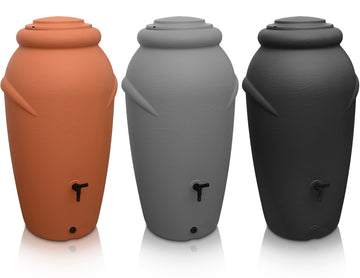
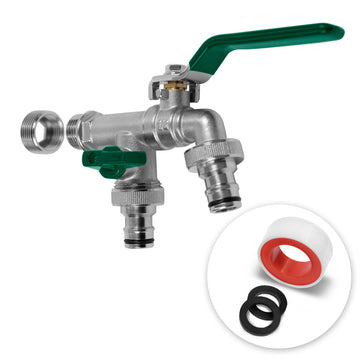
![Drei hohe YourCasa Regentonne 240 Liter [Wellen-Design] - Frostsicher & UV-beständige Gartentöpfe in den Farben Schwarz, Grau und Terrakotta, jeweils mit Drainagesystem für nachhaltige Bewässerung.](http://yourcasa.de/cdn/shop/files/ohnelogo_b8aeecac-557e-4106-a999-e77dcd160209.jpg?v=1707130230&width=360)
